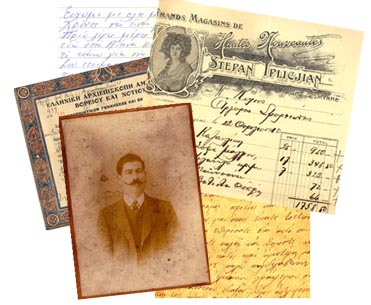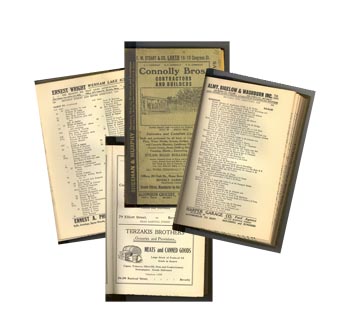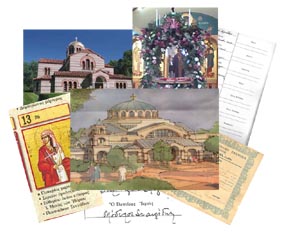 |
|
 |
|
 |
|
Introduction Who can resist the genealogical call of the Sirens? This haunting melody tugs at our hearts, our inner selves, as it slips across time to beckon us toward our roots. And we have heeded this rhythmic tune. Our hearts have responded in measured beats, matching the ancient metrical patterns and urging us on toward our goal. As a result, there has been an enormous increase in the numbers of Greek-Americans researching their family trees in recent years. Many "papoudes" and "yiayiades" have taken initial steps in compiling a list of ancestors for their children. Enthused young people have likewise taken up the banner of Hellenic genealogy, working patiently to fill in their family trees. Yet, their success has been limited, as it has been reported to me during my introductory workshops on Greek genealogy. Customarily, researchers have managed to piece together two earlier generations: the names of their own parents (and their parents' siblings) and the names of their grandparents (often without siblings). Occasionally, a researcher has reported trying—generally unsuccessfully—to obtain data in Greece. The chief problems facing Hellenic genealogy, however, are not barriers of language or physical remoteness of Greek records, but one of methodology. Persons based in the U.S need to begin their search in the U.S. and focus on obtaining the original, full Greek name of their immigrant ancestor and of their village of origin before attempting to conduct research in Greece. Armed with this information, the search through Greek records will become more productive. To locate this key information, begin a U.S.-based search as outlined below. The order is important, since each step can provide necessary information for successive steps. When you have completed these steps, expand your search to include other U.S. records such as vital records, military, funerary, and so on. These ancillary records will provide a fuller picture of your ancestor's life in the U.S. and will serve as important corroboration of data. Click on one of the links below to go to that section: Step One: Check the Ellis Island Foundation online database for passenger ship records Step Two: Check local annual city directories for your ancestor's entries Step Three: Search through federal census records Step Four: Check naturalization records, including "first papers" or Declarations of Intent Step Five: Check local U.S. Orthodox parish ecclesiastical records A Few Helpful Tips for Success Selected General Genealogical Printed References Selected Printed References Specific for Hellenic Genealogical Research Websites Recommended for U.S.-based Hellenic Genealogical Research |
|
Step One: Check the Ellis Island Foundation online database for passenger ship records A search through passenger ship records has recently become quite simple since the advent of the online database. Visit the foundation website at http://www.ellisislandrecords.org and follow the directions and prompts to conduct a computerized search of their massive database. For details and helpful examples, see our article, "Immigrant Passenger Ship Records Now Online: Guide to Retrieving Records from the Ellis Island Foundation Database," in the genealogy section of the Hellenic Communication Service website at http://www.HellenicComServe.com/genealogy.html. |
|
| Keep in mind that this database only covers New York entries during the years 1892-1924; not all immigrants came through Ellis Island (Castle Gardens or "Kastingari")—some arrived in Boston, Portland (Maine), other Massachusetts ports, Rhode Island, the mid-Atlantic states, Gulf coast states, or across the Canadian border. |
 |
| What information can one expect to find from this database? Depending on the year of entry, since Congress changed information-gathering requirements for civil servants and ships' agents over the years, immigrants supplied their birthplaces, names of closest living relatives at permanent residences, destinations, names and addresses (and relationships) of persons whom they were going to see in the U.S., whether or not they had been in the U.S. before, their occupation and age, a physical description, marital status, whether or not they could read and write, and other data. A successful search of this database can, in some cases, supply a researcher with all of the information necessary to begin inquiries abroad. It is the single most important step for any Greek-American who is researching family history. |
|
| If you cannot locate your immigrant ancestor's records on the Ellis Island Foundation's online database, there are other options. These records were hand-keyed by thousands of volunteers over the last decade form microfilm rolls of the original ships' records held at the National Archives and Records Administration (http://www.nara.gov). It is simple to view these index rolls and then to rent or buy the appropriate microfilm rolls from them through this webpage: |
A successful search of this database can, in some cases, supply a researcher with all of the information necessary to begin inquiries abroad. |
(http://www.archives.gov/research_room/genealogy/research_topics/immigration.html#where).; these can also be ordered through interlibrary loan at one's local public library. Actual viewing must take place with a microfilm reader; machines at the local library will suffice. Index rolls use a system called "Soundex," based on phonetics, meaning that a surname, or last name, is converted phonetically to a special code. If you have difficulty locating your ancestor's name, try other transliterations of your surname into English; for assistance, consult our article," Methods of Transliteration and the Causes of Variant English Spellings of Greek Proper Names," available from Hellenic Historical and Genealogical Association. But this process of reviewing the microfilm rolls is more time-consuming than checking out the online database. Before ordering the rolls, make another attempt to use the online database. Try variant spellings of the ancestor's name. Use phonetic variations, use transliteration options, and even supplant letters that are often misread in handwriting. For more information about passenger ship arrival records in general, consult several excellent sources: Collette, John Philip. They Came in Ships. A Guide to Finding Your Immigrant Ancestor's Arrival Record. 1989. Revised edition. Salt Lake City, Utah: Ancestry, 1993. Gallagher, Jim. "Ellis Island Records. Shaping People's Expectation." Heritage Quest (July/August 2001): 30-39. Szucs, Lorretto Dennis. "Ship Passsenger Arrival Lists." In They Became Americans. Finding Naturalization Records and Ethnic Origins, 74-82. Salt Lake City, Utah: Ancestry Incorporated, 1998. "Passenger Arrival Lists," Chap. 2 in Guide to Genealogical Research in the National Archives. 1983. Revised edition. Washington, D.C.: National Archives Trust Fund Board for the National Archives and Records Administration, 1985. Return to top of page |
|
Step 2. Check local annual city directories for your ancestor's entries. Armed with names and U.S. addresses obtained from passenger ship records, researchers can then look up the immigrant's address in successive volumes of the annual city directory of that city. Family names, or surnames, are arranged alphabetically. |
|
| Local libraries or historical societies carry these volumes, generally in a restricted reference or local history section. In the last couple of years, however, some of the online subscription services have begun to offer databases of these directories. (See Ancestry.com at http://www.ancestry.com.) These directories also list the occupation of every resident, and their business and home address. Some directories will also provide the name of the spouse of each person listed—another aid. Occasionally, these tomes will indicate that a resident had moved or passed away. |
 |
Check the alphabetical listing of streets, too, in another section of this directory, and note the voting ward for that street—this information will be helpful when census records are consulted. If the directory includes a map of the city streets, note the names of nearby streets in case there is a "Greek" section in that city or town; quite often researchers will find that relatives reside on nearby streets (if not at the same address as the target ancestor). At the back of the directory is another section that is very helpful: the business directory. Here are listed alphabetically all of the businesses of the city, along with the names of their owners and relevant addresses. It's possible to trace the mercantile career of an ancestor through the business directory by checking the business section in successive years. For additional information on using city directories, consult a website dedicated to city directories, one developed by Genealogical Research Associates of Utah, at the URL: http://www.uscitydirectories.com. We especially recommend the following excellent article in the Heritage Quest magazine (http://www.heritagequest.com), which is now available online for viewing at http://www.heritagequest.com/magonline/html/citydirectory.html: Meyerink, Kory L. "Effective Use of City Directories." Heritage Quest (March/April 2001): 25-39. [For searches in New Hampshire and other New England states, note that towns and cities also produced yearly annual reports. In these bound reports—separate from the resident directories—there were sections in the back on vital statistics, listing all the births, marriages, and deaths in the community. These chronological entries can be a treasure trove of data, yielding birthplaces and names of parents or grandparents, etc.] Return to top of page Step 3. Search through federal census records These records can be found in several places: at the local library (microfilm rolls); rented or purchased from the National Archives and Records Administration (microfilm rolls, http://www.nara.gov); or online through a subscription service like Ancestry.com (http://www.ancestry.com). Before beginning your search, visit the Ancestry website and download the free forms for recording federal census information (http://www.ancestry.com/save/charts/census.htm): these are copies of the original census forms and will help you organize your data and record it properly. By far the most convenient method—and the priciest—is the online subscription service. Registration for this service is simple and quick: just follow the online prompts. Note that, although not all federal census records are online, the database of this national service is growing monthly. To retrieve the appropriate data, one simply types in the desired surname in the boxes provided and hits the "enter" key on the keyboard. The computer of the massive registry will search through its database for the name specified and list its findings. Researchers can even view the microfilm copy of the actual, handwritten census record on their computer screens with a few more clicks of the mouse. Reading the microfilm rolls produced by NARA to find one's ancestor is a cheaper alternative to the online subscription service. In most cases, it's free, particularly if the local public library or university library carries a full set of microfilm rolls for the entire state and the corresponding index rolls. Reference librarians can help you set up the microfilm readers. Try to get one that prints out, so that you can take a copy home with you. But in order to find the correct roll, if no index is available, one has to know the voting ward or local address of the immigrant ancestor at the time of the census. This is where information from the annual city directory comes in handy. Without the address of one's immigrant ancestor, one may have to make a series of trips to the library and spend a number of hours searching through thousands of entries. The same applies to using microfilm rolls rented or purchased from NARA. The search through the census records can be rewarding. Not only can one learn personal information about one's ancestor, but quite often census takers listed whether or not an individual was a citizen. If he or she was a resident alien, the year of entry was also recorded; if naturalized, the year of naturalization. This information is particularly helpful for locating naturalization papers, even for those persons who didn't complete the entire process of obtaining U.S. citizenship. For more information about the federal census, see the following helpful articles: Bockman, Jeffery A. "Are Your Ancestors Hiding in the Twentieth-Century Censuses?" Heritage Quest (March/April 2002): 30-37 Gillette, Merrill E. "Soundex Codes." Heritage Quest (March/April 2002): 44-50. Meyerink, Kory. "The 1910 Censuses: the Beginnings of Twentieth-Century Research." Heritage Quest (March/April 2002): 16-23. Slater-Putt, Dawne. "Troubleshooting the Twentieth-Century Censuses." Heritage Quest (March/April 2002): 38-43. Return to top of page Step 4. Check naturalization records, including "first papers" or Declarations of Intent. Naturalization was a multi-step process. Resident aliens had to complete and file "first papers," the "Declaration of Intent," and reside in the U.S. for three years before completing the process. (The number of years of residence varied according to Congressional legislation, but the average was about three years.) One major exception to this rule was for young men who were naturalized upon being drafted to serve in World War I. In many cases, initial papers were filed at a courthouse in or near the city in which an immigrant ancestor first settled. Subsequent petitions or forms, however, could have been filed anywhere in the U.S., another reason for using passenger ship records to determine an immigrant ancestor's first destination within the U.S. For cases around the turn of the century (early1900s), many records will no longer be stored at the courthouse, but at state and national archives (National Archives and Records Administration). The naturalization papers in some state archives have been indexed by county and then alphabetically by surname, but in a number of others, such forms remain unindexed. |
|
For more detailed information about the court systems of each state and the naturalization process, consult an excellent text by Loretto Dennis Szucs: They Became Americans: Finding Naturalization Records and Ethnic Origins (Salt Lake City, Utah: Ancestry Incorporated, 1998). The exact address and contact information for each state archive can be found by visiting the "State Archives and Records Program Links" page of the website of the Council of State Historical records coordinators (COSHRC) at the URL: |
 |
| http://www.coshrc.org/arc/states.htm or the "State Archives Referral List" webpage of the Rootsweb website (http://www.rootsweb.com) at the address http://www.rootsweb.com/~orwcfhs/state_archives.htm, a list originally supplied by the Secretary of State of Georgia, Cathy Cox. In the case of immigrants who became naturalized after September 27, 1906, researchers should contact U.S. Citizenship and Immigration Services (formerly, Immigration and Naturalization Service) for copies of all records relating to the naturalization (http://uscis.gov/graphics/aboutus/history/NatzRec/NATREC.htm) through the Freedom of Information Act: Director, Freedom of Information Act/Privacy Act Program, 111 Massachusetts Avenue, N.W., 2nd Floor, ULLICO Building, Washington, D.C. 20529, (202) 272-8269. Experts indicate that occasionally NARA or INS will have in their files interesting genealogical items, such as copies of hand-written letters or photos and other materials, submitted by immigrants during the naturalization process. Researchers can expect to find the village of origin among these records—just as they can on the Ellis Island Foundation online database—along with other types of personal information (in most cases, depending on the year, since Congress modified regulations concerning naturalizations). The names of witnesses often provide other clues for family trees; immigrants usually asked other relatives or close friends or business associates to accompany them and sign their documents. When the Ellis Island records don't yield any information, these naturalization records can serve as substitutes, providing the date and place of entry, the name of the ship on which they traveled, and so forth. For more information about naturalization, see especially the following excellent text: Schaefer, Christina K. Guide to Naturalization Records of the United States. 1997. Third Printing. Baltimore, Maryland: Genealogical Publishing Co., Inc., 1998. Return to top of page Step 5. Check local U.S. Orthodox parish ecclesiastical records. This step cannot be omitted if one wishes to conduct research in Greece and one does not have the Greek name of one's immigrant ancestor. For it is here, with these records, that one will find the original, full Greek name. And in many cases, the village or city of origin—in Greek—will also be listed. Relevant records for most Greek immigrants will be found at a local parish, not a diocesan or archdiocesan center. Why? Because these hierarchical centers were founded after the end of the largest waves of Greek immigration and simply do not have copies of these records dating back to the early twentieth century. |
|
But consulting local parish records will be challenging for a number of reasons. First, most parishes do not make their records public. One must contact a local parish and ask for permission to view the ledgers—or ask that someone research the records. Second, the records are handwritten in Greek. Even those who reach typewritten Greek will experience some difficulty in deciphering an individual's script, and not every person who speaks Greek can read handwriting. Third, staffing is skeletal in most parishes and older records are usually in storage; researchers should be prepared to send a "tip" for research and copying costs and should allow sufficient time for staff to comply with a request when corresponding at a distance. |
 |
Finding the correct parish may also require a little more sleuthing. Let me offer an example. My paternal grandparents' children were not all baptized by priests from the same parish church. Why? The four Greek Orthodox Churches in that state were not all established at the same time. Consequently, the older children were baptized by a priest from a neighboring city where a local Orthodox Church was already established. The "middle" children were baptized by the local parish priest—after their own Greek community had organized and purchased a church. One of the "babies" was baptized by a priest from a third Greek Orthodox community because of the local priests' travel schedules and emergency duties. In other words, this means that baptismal records for all six children were spread out over three parishes. In researching the ecclesiastical records of one's own immigrant ancestor, be sure to inquire about the dates of establishment of all surrounding churches. If any records prove elusive, check the ledgers of neighboring communities. Return to top of page |
|
|
|
|
Selected General Genealogical Printed References: Greenwood, V., The Researcher's Guide to American Genealogy, 3rd ed. Eichholz, A., Ancestry's Red Book: American State, County & Town Sources, Rev. ed. Swan, J. The Librarian's Guide to Genealogical Research. Meyerink, K., Printed Sources: A Guide to Published Genealogical Records. Szucs, L. and S. Luebking, The Source: A Guidebook of American Genealogy, Rev. ed. Bentley, E., Genealogist's Address Book. |
|
Mary Papoutsy is a Classicist and former educator at the secondary and collegiate levels. She lectures on the Classics and Hellenic genealogy, having established the Hellenic Historical and Genealogical Association (HHGA) in 2000. For more information about HHGA, see the webpages of this group hosted by Hellenic Communication Service. Mrs. Papoutsy and her husband, Christos, created the Christos and Mary Papoutsy Endowed Chair in Business Ethics at Southern New Hampshire University. They also founded and are the publishers of Hellenic Communication Service (HCS). For more information about Mrs. Papoutsy or HCS, see the About Us section of the HCS Home Page. HCS readers are invited to read other related articles and material that Mrs. Papoutsy has contributed to the website, including "Immigrant Passenger Ships' Records Now Online: Guide to Retrieving Records from the Ellis Island Foundation Database," "Eyewitness Account of the Asia Minor Catastrophe. George Tsoubariotis. Translated by Mary Papoutsy," "Out of the Balkans. Book Details Lives of Early 20th Century Greek Immigrants. A book review by Mary Papoutsy," "Arcadia, My Arcadia a Must-Read," "Smyrna 1922: The Destruction of a City. A Review by Christos and Mary Papoutsy," "Kandylakia: Roadshrines to Lives Lost and Saved," "Interested in Greek Memorabilia? Try E-Bay," "Iconographer Ann Welch Creates Icon-Fresco for a Traditional Island Village," and " Athens: A Study in Contrasts of Expression."
|
|
|
|
|
|
2000 © Hellenic Communication Service, L.L.C. All Rights Reserved.
http://www.HellenicComServe.com |
|
